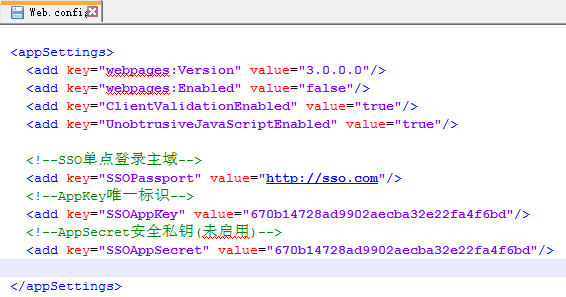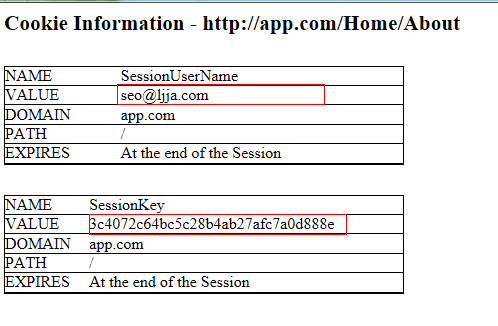ASP.NET MVC SSO单点登录实现代码有什么?
实验环境配置
HOST文件配置如下:
127.0.0.1 app.com
127.0.0.1 sso.com
IIS配置如下:

应用程序池采用.Net Framework 4.0

注意IIS绑定的域名,两个完全不同域的域名。
app.com网站配置如下:

sso.com网站配置如下:
memcached缓存:

数据库配置:

数据库采用EntityFramework 6.0.0,首次运行会自动创建相应的数据库和表结构。
授权验证过程演示:
在浏览器地址栏中访问:http://app.com,如果用户还未登陆则网站会自动重定向至:http://sso.com/passport,同时通过QueryString传参数的方式将对应的AppKey应用标识传递过来,运行截图如下:
URL地址:http://sso.com/passport?appkey=670b14728ad9902aecba32e22fa4f6bd&username=

输入正确的登陆账号和密码后,点击登陆按钮系统自动301重定向至应用会掉首页,毁掉成功后如下所示:

由于在不同的域下进行SSO授权登陆,所以采用QueryString方式返回授权标识。同域网站下可采用Cookie方式。由于301重定向请求是由浏览器发送的,所以在如果授权标识放入Handers中的话,浏览器重定向的时候会丢失。重定向成功后,程序自动将授权标识写入到Cookie中,点击其他页面地址时,URL地址栏中将不再会看到授权标示信息。Cookie设置如下:

登陆成功后的后续授权验证(访问其他需要授权访问的页面):
校验地址:http://sso.com/api/passport?sessionkey=xxxxxx&remark=xxxxxx
返回结果:true,false
客户端可以根据实际业务情况,选择提示用户授权已丢失,需要重新获得授权。默认自动重定向至SSO登陆页面,即:http://sso.com/passport?appkey=670b14728ad9902aecba32e22fa4f6bd&username=seo@ljja.cn 同时登陆页面邮箱地址文本框会自定补全用户的登陆账号,用户只需输入登陆密码即可,授权成功后会话有效期自动延长一年时间。
SSO数据库验证日志:
用户授权验证日志:

用户授权会话Session:

数据库用户账号和应用信息:

应用授权登陆验证页面核心代码:
/// <summary>
/// 公钥:AppKey
/// 私钥:AppSecret
/// 会话:SessionKey
/// </summary>
public class PassportController : Controller
{
private readonly IAppInfoService _appInfoService = new AppInfoService();
private readonly IAppUserService _appUserService = new AppUserService();
private readonly IUserAuthSessionService _authSessionService = new UserAuthSessionService();
private readonly IUserAuthOperateService _userAuthOperateService = new UserAuthOperateService();
private const string AppInfo = "AppInfo";
private const string SessionKey = "SessionKey";
private const string SessionUserName = "SessionUserName";
//默认登录界面
public ActionResult Index(string appKey = "", string username = "")
{
TempData[AppInfo] = _appInfoService.Get(appKey);
var viewModel = new PassportLoginRequest
{
AppKey = appKey,
UserName = username
};
return View(viewModel);
}
//授权登录
[HttpPost]
public ActionResult Index(PassportLoginRequest model)
{
//获取应用信息
var appInfo = _appInfoService.Get(model.AppKey);
if (appInfo == null)
{
//应用不存在
return View(model);
}
TempData[AppInfo] = appInfo;
if (ModelState.IsValid == false)
{
//实体验证失败
return View(model);
}
//过滤字段无效字符
model.Trim();
//获取用户信息
var userInfo = _appUserService.Get(model.UserName);
if (userInfo == null)
{
//用户不存在
return View(model);
}
if (userInfo.UserPwd != model.Password.ToMd5())
{
//密码不正确
return View(model);
}
//获取当前未到期的Session
var currentSession = _authSessionService.ExistsByValid(appInfo.AppKey, userInfo.UserName);
if (currentSession == null)
{
//构建Session
currentSession = new UserAuthSession
{
AppKey = appInfo.AppKey,
CreateTime = DateTime.Now,
InvalidTime = DateTime.Now.AddYears(1),
IpAddress = Request.UserHostAddress,
SessionKey = Guid.NewGuid().ToString().ToMd5(),
UserName = userInfo.UserName
};
//创建Session
_authSessionService.Create(currentSession);
}
else
{
//延长有效期,默认一年
_authSessionService.ExtendValid(currentSession.SessionKey);
}
//记录用户授权日志
_userAuthOperateService.Create(new UserAuthOperate
{
CreateTime = DateTime.Now,
IpAddress = Request.UserHostAddress,
Remark = string.Format("{0} 登录 {1} 授权成功", currentSession.UserName, appInfo.Title),
SessionKey = currentSession.SessionKey
}); 104
var redirectUrl = string.Format("{0}?SessionKey={1}&SessionUserName={2}",
appInfo.ReturnUrl,
currentSession.SessionKey,
userInfo.UserName);
//跳转默认回调页面
return Redirect(redirectUrl);
}
}
Memcached会话标识验证核心代码:
public class PassportController : ApiController
{
private readonly IUserAuthSessionService _authSessionService = new UserAuthSessionService();
private readonly IUserAuthOperateService _userAuthOperateService = new UserAuthOperateService();
public bool Get(string sessionKey = "", string remark = "")
{
if (_authSessionService.GetCache(sessionKey))
{
_userAuthOperateService.Create(new UserAuthOperate
{
CreateTime = DateTime.Now,
IpAddress = Request.RequestUri.Host,
Remark = string.Format("验证成功-{0}", remark),
SessionKey = sessionKey
});
return true;
}
_userAuthOperateService.Create(new UserAuthOperate
{
CreateTime = DateTime.Now,
IpAddress = Request.RequestUri.Host,
Remark = string.Format("验证失败-{0}", remark),
SessionKey = sessionKey
});
return false;
}
}
Client授权验证Filters Attribute
public class SSOAuthAttribute : ActionFilterAttribute
{
public const string SessionKey = "SessionKey";
public const string SessionUserName = "SessionUserName";
public override void OnActionExecuting(ActionExecutingContext filterContext)
{
var cookieSessionkey = "";
var cookieSessionUserName = "";
//SessionKey by QueryString
if (filterContext.HttpContext.Request.QueryString[SessionKey] != null)
{
cookieSessionkey = filterContext.HttpContext.Request.QueryString[SessionKey];
filterContext.HttpContext.Response.Cookies.Add(new HttpCookie(SessionKey, cookieSessionkey));
}
//SessionUserName by QueryString
if (filterContext.HttpContext.Request.QueryString[SessionUserName] != null)
{
cookieSessionUserName = filterContext.HttpContext.Request.QueryString[SessionUserName];
filterContext.HttpContext.Response.Cookies.Add(new HttpCookie(SessionUserName, cookieSessionUserName));
}
//从Cookie读取SessionKey
if (filterContext.HttpContext.Request.Cookies[SessionKey] != null)
{
cookieSessionkey = filterContext.HttpContext.Request.Cookies[SessionKey].Value;
}
//从Cookie读取SessionUserName
if (filterContext.HttpContext.Request.Cookies[SessionUserName] != null)
{
cookieSessionUserName = filterContext.HttpContext.Request.Cookies[SessionUserName].Value;
}
if (string.IsNullOrEmpty(cookieSessionkey) || string.IsNullOrEmpty(cookieSessionUserName))
{
//直接登录
filterContext.Result = SsoLoginResult(cookieSessionUserName);
}
else
{
//验证
if (CheckLogin(cookieSessionkey, filterContext.HttpContext.Request.RawUrl) == false)
{
//会话丢失,跳转到登录页面
filterContext.Result = SsoLoginResult(cookieSessionUserName);
}
}
base.OnActionExecuting(filterContext);
}
public static bool CheckLogin(string sessionKey, string remark = "")
{
var httpClient = new HttpClient
{
BaseAddress = new Uri(ConfigurationManager.AppSettings["SSOPassport"])
};
var requestUri = string.Format("api/Passport?sessionKey={0}&remark={1}", sessionKey, remark);
try
{
var resp = httpClient.GetAsync(requestUri).Result;
resp.EnsureSuccessStatusCode();
return resp.Content.ReadAsAsync<bool>().Result;
}
catch (Exception ex)
{
throw ex;
}
}
private static ActionResult SsoLoginResult(string username)
{
return new RedirectResult(string.Format("{0}/passport?appkey={1}&username={2}",
ConfigurationManager.AppSettings["SSOPassport"],
ConfigurationManager.AppSettings["SSOAppKey"],
username));
}
}
示例SSO验证特性使用方法:
[SSOAuth]
public class HomeController : Controller
{
public ActionResult Index()
{
return View();
}
public ActionResult About()
{
ViewBag.Message = "Your application description page.";
return View();
}
public ActionResult Contact()
{
ViewBag.Message = "Your contact page.";
return View();
}
}
总结:
从草稿示例代码中可以看到代码性能上还有很多优化的地方,还有SSO应用授权登陆页面的用户账号不存在、密码错误等一系列的提示信息等。在业务代码运行基本正确的后期,可以考虑往更多的安全性层面优化,比如启用AppSecret私钥签名验证,IP范围验证,固定会话请求攻击、SSO授权登陆界面的验证码、会话缓存自动重建、SSo服务器、缓存的水平扩展等。
源码地址:http://xiazai.jb51.net/201701/yuanma/SmartSSO_jb51.rar
以上就是本文的全部内容,希望对大家的学习有所帮助,也希望大家多多支持路饭。
本文地址:http://www.45fan.com/bcdm/87244.html
